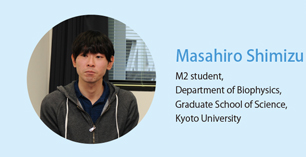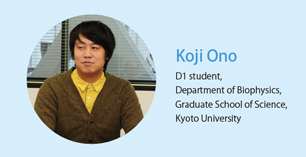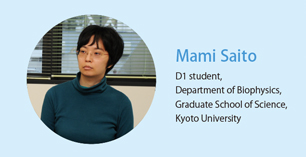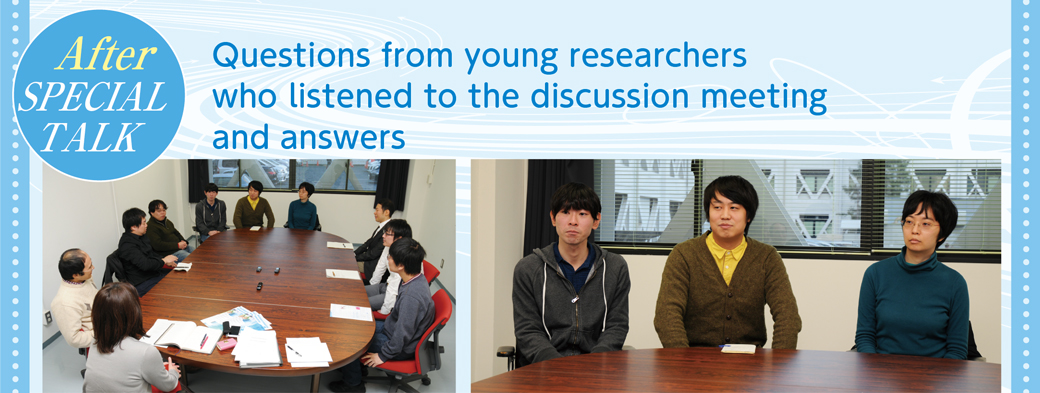

I listened to the stories of leading researchers, and felt the power of calculation experiments anew. Molecular simulation is advancing, and aiming to “thoroughly visualize an entire cell at the molecular level”. The progress of multiscale simulation has brought us such a vision. In order to combine simulation results on different scales, such as all-atom calculation and coarse-graining calculation, we need long and large-system calculation at each phase. I am just amazed by the power of HPC, which can perform such calculations. I also want to contribute to development of molecular simulation, which will reveal larger macroscopic phenomena in terms of smaller microscopic molecular mechanisms.

I attended this round-table discussion for the first time. I heard diverse opinions of people who are using a computer to understand biological phenomena. I found it most impressive that their approaches are mutually connected via the K computer. There are diverse approaches ranging from microscopic ones such as quantum chemical calculation, to macroscopic simulation of reactions taking place in a cell. It is important to understand each stage, but the relationships among the stages are crucial as well. Until the K computer, the relationships could not be fully investigated due to lack of computational resources, but the K computer has further expanded the scope of joint studies. That is what I felt at the discussion.

The researchers in the conversation are using diverse approaches. I felt that the approaches used for constructing models that meet the scale of each research target are not yet established, nor have reached the level of gaining support by the majority. This is probably because they are in the blind search stage looking for ways to assemble calculation models that can well reproduce actual phenomena, and each is using his or her overall experience. Due to the capacity limit of the computer, they have to choose similarity and interaction levels depending on their scale in order to not trade off processing time with precision and resolution. As a supercomputer like the K computer became accessible to many people, the number of researchers involved in this field is likely to increase. I expect that most of the difficulties in constructing models will be solved by large numbers of studies on model construction.
【Shimizu】 There was a discussion about collaboration with experimenters. With the ability to do large-scale simulation, I think it has become possible to deliver results that are easier to understand for experimenters as well. How do you think collaboration with experimenters will develop in the future?
Iwamoto: What we are doing now is simulation at the molecular resolution; this simulation is compatible with measurement experiments on one molecule, so I think it is a field in which comparing simulation and experiment is straightforward. However, since simulation at the level of a cell is not straightforward with this simulation method, there are still difficulties for comparison with experiments.
【Shimizu】 Regarding collaboration with experimenters, what sort of new development do you see in the future?
Iwamoto: While the accuracy of computation has increased, the difficulty lies in validating that [process] experimentally. So, if the question is "now that we have the ability to use a large calculator, will we be able to have new collaborations immediately?", I feel that it would be difficult.
【Ono】 The HPC capability you are asking for is mainly to run many independent replicas. Is the K computer a machine that addresses this demand adequately?
Yu: Do you mean whether the structure is appropriate for running many replicas? Since running many jobs in parallel is not what I am doing, I do not have a sense of use for doing that with the K computer. However, since it has a gigantic CPU core, it should be appropriate as a machine.
【Ono】 Supposing that a computation is run with one node/one core by Dr. Ishida's own machine, and one is run with one node/one core by the K computer, which one will deliver computation speed?
Ishida: If it were around one node, I suspect the K computer would have close to no appeal, since the selling point of the K computer is the ability to do parallel computing on a large scale. You really want to do computing with many nodes.
【Ono】 I have a question for Dr. Yu. I believe that the main program has completed running on the K computer. Does the analysis program in the next step also need to run on the K computer?
Yu: No, the analysis program is not being run on the K computer. The analysis is carried out mainly using our in-house PC cluster.
【Ono】 Does it mean that your laboratory is near the K computer, and that it is easy to transfer data? Doesn't data transfer take time when you are far away?
Yu: I think you don’t have to wait, for instance for one week or two weeks, for data transfer as well. Then, if you have a storage ready, you can put everything in there, and successively extract and analyze the data.
Kamiya: I agree. Actually, data transfer to our laboratory is not slow.
Yu: It should not be a significant problem.
【Ono】 One last point: are you not going to run any sub-program on the K computer in the future?
Yu: Correct. The computation is not that heavy for the analysis itself, not to the extent of using the K computer for now.
【Ono】 Even when exhaustively examining the relative positions between proteins, or the like, for instance?
Yu: For instance, we are computing things such as distance matrices between proteins’ centers of mass, but they are not worth computing with the K computer. However, when attempting to compute the interaction forces or energies for all the protein pairs, this alone is a calculation that is almost as heavy as a molecular dynamics simulation. I believe that such an analysis must be done with the K computer.
【Saito】 In "GENESIS" that Dr. Yu is using, how do you decide the types of molecules and nodes?
Yu: The cellular environment model needed for the simulation was created by a researcher in the Sugita team at RIKEN(1) and a collaborator in the United States(2), not by myself. The modeled system is the mycoplasma cytoplasm. We are incorporating proteins related to the metabolic network in numbers that are close to their intracellular concentrations. Except for membranes or membrane proteins and DNA, almost all the biomolecules are included in this model system. How this is was decided? Since the entire genome of mycoplasma is known, almost all the protein types and metabolic networks can be determined. In addition, experimental data are already available as far as proteome analysis and metabolome analysis, allowing for estimates of what sorts of molecules are present and at which concentrations. In this way, we use a variety of experimental data comprehensively to make a decision. We are using the molecular dynamics simulation program “GENESIS” developed by the Sugita team and the K computer to run the all-atom model of the cellular environment made in this fashion. For the number of nodes, as mentioned earlier, the optimum number of nodes was determined by multiple trials and errors.
(1) Dr. Takaharu Mori (Theoretical Molecular Science Laboratory. RIKEN) and Dr. Ryuhei Harada (currently, Tsukuba University)
(2) Professor. Michael Feig (Michigan State University)
【Saito】 Dr. Iwamoto, you are computing intramolecular networks. Do you think computation of intercellular networks will be possible in the future?
Iwamoto: I think that basically, the intercellular [option] will become possible as well. However, regarding intercellular exchanges, the exchanges are happening through small molecules and such, although the detailed mechanism is not known. If such things could be learned, I think that, for instance, given several cells, including intercellular communications to calculate their behavior as a group of cell will become possible.

















